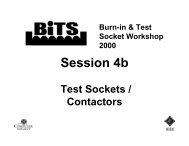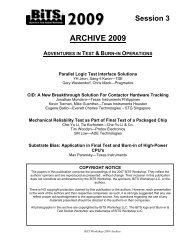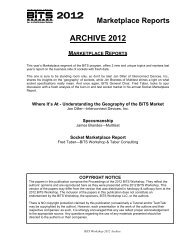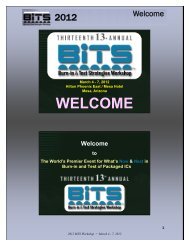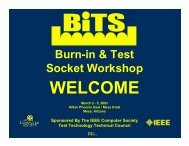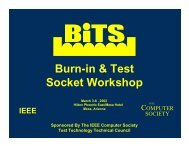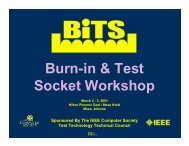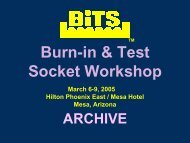Gryphics / Molex Development Program - BiTS Workshop
Gryphics / Molex Development Program - BiTS Workshop
Gryphics / Molex Development Program - BiTS Workshop
You also want an ePaper? Increase the reach of your titles
YUMPU automatically turns print PDFs into web optimized ePapers that Google loves.
IEEE<br />
Burn-in & Test<br />
Socket <strong>Workshop</strong><br />
March 4 - 7, 2001<br />
Hilton Mesa Pavilion Hotel<br />
Mesa, Arizona<br />
Sponsored By The IEEE Computer Society<br />
Test Technology Technical Council<br />
IEEE<br />
COMPUTER<br />
SOCIETY
COPYRIGHT NOTICE<br />
• The papers in this publication comprise the proceedings of the 2001<br />
<strong>BiTS</strong> <strong>Workshop</strong>. They reflect the authors’ opinions and are reproduced as<br />
presented , without change. Their inclusion in this publication does not<br />
constitute an endorsement by the <strong>BiTS</strong> <strong>Workshop</strong>, the sponsors, or the<br />
Institute of Electrical and Electronic Engineers, Inc.<br />
· There is NO copyright protection claimed by this publication. However,<br />
each presentation is the work of the authors and their respective<br />
companies: as such, proper acknowledgement should be made to the<br />
appropriate source. Any questions regarding the use of any materials<br />
presented should be directed to the author/s or their companies.
Technical <strong>Program</strong><br />
Session 2<br />
Monday 3/05/01 10:30AM<br />
Directions In Test Socketing<br />
“Spring Contact Probes For IC Device Testing”<br />
Tim Dowdle – Synergetix<br />
“Strip Test - Evolution, Considerations And Resources”<br />
Brian Crisp - Everett Charles Technologies<br />
“Lowering The Cost Of High Performance Test And Burn-in”<br />
James Rathburn – <strong>Gryphics</strong>, Inc.
Spring Contact Probes<br />
for<br />
IC Device Testing<br />
Presented by<br />
Tim Dowdle<br />
1
Proven Spring Contact Probe<br />
Simplifies Testing of IC Devices<br />
• True Vertical Probing<br />
• Customizable Geometry<br />
• Ease of Manufacture<br />
• Cost Effective<br />
• Extreme Duty Capable<br />
2
Disproving the Myth<br />
• Long signal path length and high<br />
inductance spring contact<br />
probes do not make the<br />
optimum test socket contact.<br />
• Test engineers were forced to<br />
build their own sockets<br />
borrowing a readily available<br />
technology.<br />
• Spring contact probes originally<br />
designed for printed circuit<br />
board (PCB) testing fill the need.<br />
3
Disproving the Myth<br />
• The PCB probe commonly used in the past cannot<br />
support the testing requirements for the new<br />
generation of fine-pitch, high-speed devices, such as<br />
BGA and CSPs.<br />
• Miniaturization down to .25mm (.010”) and test<br />
speeds well above 1GHz, drive manufacturers to<br />
develop contact designs which meet ultra-fine pitch<br />
requirements.<br />
• By reducing size and length of the spring contact<br />
probe, it becomes essentially transparent in the<br />
electrical test path maintaining low, consistent<br />
contact resistance.<br />
4
Spring Contact Probe<br />
Features<br />
• Vertical probing motion.<br />
• DUT board design is a true reflection of<br />
the device lead pattern.<br />
• Spring probes are retained in test<br />
sockets with drilled holes offering<br />
unlimited capacity to customize sockets<br />
for specific applications.<br />
5
Spring Contact Probe<br />
Features<br />
• Gold plated crimped outer barrel, inner spring,<br />
with either one or two plungers.<br />
• The spring is designed so that a “biasing”<br />
effect is created inside the barrel, forcing the<br />
plungers against the inner surface of the barrel.<br />
• Utilizing this biasing feature, current flow<br />
follows a plunger−barrel−plunger path keeping<br />
the spring out of the conductive path.<br />
• Reliable contact force and electrical<br />
performance in temperature extremes from<br />
50°C to 150°C.<br />
6
Reduced Cost of Ownership<br />
• When refurbishment is required the use of<br />
individual, self-contained contacts simplifies field<br />
replacement of a single contact or the entire array.<br />
• High cycle life and easy refurbishment capability<br />
reduce the overall cost of ownership.<br />
• The spring contact probe allows versatility within<br />
the same test socket for use in automated test,<br />
engineering characterization, and custom burn-in<br />
tests.<br />
7
Design Flexibility and<br />
Quality Management<br />
• Socket manufacturers are dependent upon<br />
purchasing their contact technology from an<br />
outside supplier. Consequently, they are<br />
forced to develop the socket design around<br />
the existing features of that technology.<br />
• Socket manufacturers who design and build<br />
their contact technology in house have a<br />
definite advantage.<br />
8
Design Flexibility and<br />
Quality Management<br />
• Device manufacturers are developing new CSP, BGA,<br />
LGA, and peripheral packages at a dizzying pace.<br />
• Due to the variables involved in each package design<br />
and test methodology, a single spring contact probe<br />
will not be effective in every application.<br />
9
Optimal Device Test<br />
Conditions<br />
• High contact forces are becoming a critical<br />
concern for BGA devices.<br />
• The contact force of the spring probe can<br />
easily be redesigned to avoid extreme<br />
forces in the handler and minimize the<br />
pressure against the devices and the DUT<br />
board, while maintaining the electrical and<br />
mechanical integrity.<br />
10
Optimal Device Test<br />
Conditions<br />
• BGA devices with a .5mm diameter solder ball on<br />
.8mm pitch may use a different spring contact probes<br />
than a device with a .75mm diameter solder ball on<br />
1.27mm pitch.<br />
• The probe tip will utilize a 4-point crown or other tip<br />
style to push the contact area away from the center of<br />
the ball. This will allow the probe tip to contact only<br />
the outer periphery of the ball avoiding all contact with<br />
the central keep-out area.<br />
SEBM photo of witness<br />
marks left on a .75mm<br />
diameter ball using a four<br />
point crown tip style.<br />
11
Optimal Device Test<br />
Conditions<br />
• It is imperative to use varying probe tip diameters<br />
and spring forces to achieve proper ball fit for<br />
each device under test.<br />
• Factors involved in the selection of the contact are<br />
lead pitch, lead type, solder ball diameter, number<br />
of leads, available insertion force of the handling<br />
system, and rigidity of the DUT board.<br />
• The spring contact probe offers many variable<br />
design factors that can be customized to improve<br />
the performance of the test socket.<br />
12
Electrical Performance<br />
• Spring contact probes prove to be electrically<br />
superior to many other technologies. Test sockets<br />
utilizing this technology today, are characterized<br />
with less than one nano Henry self-inductance.<br />
• These diminutive contacts excel in the areas of<br />
low contact resistance and electrical repeatability.<br />
A standard design threshold of less than 50mΩ is<br />
observed for most contacts of this style.<br />
• Designs under development for new spring<br />
contact technologies will drive the contact<br />
resistance even lower.<br />
13
Electrical Performance<br />
14
Long Life by Design<br />
• The mechanics of a spring probe are largely contained<br />
inside the probe’s barrel, essentially creating a closed<br />
contact architecture.<br />
• Spring probes are an ideal choice for use in<br />
contaminated environments.<br />
• Spring probes used in today’s test sockets can last<br />
more than half a million cycles when manufactured to<br />
very tight specifications and properly cleaned and<br />
maintained in the handler. Pi co Pin Average<br />
Pico<br />
Resistance(MilliOhms)<br />
250<br />
200<br />
150<br />
100<br />
50<br />
0<br />
Re sis tan ce (M illiOh<br />
250<br />
200<br />
150<br />
100<br />
50<br />
0<br />
Resistance LCT thru 1 Million Cycles at Ambient Temperature<br />
Pin Average<br />
Re sistan ce LC T th ru 1 Million Cyc les at Ambient T emp eratu re<br />
0 10 20 30 40 50 60 70 80 90 100 150 200 250 300 350 400 450 500 600 700 800 900 1000<br />
0<br />
10<br />
20<br />
30<br />
40<br />
50<br />
60<br />
70 80<br />
90<br />
Thousands of C ycles<br />
100<br />
Thousands of Cycles<br />
150<br />
200<br />
250<br />
300<br />
350<br />
400<br />
450<br />
500<br />
15<br />
600<br />
700<br />
800<br />
900 1000
Future Socket Trends<br />
• Test sockets are shrinking in size to accommodate<br />
smaller footprints.<br />
• New high-speed devices above 1GHz will require<br />
the new generation of high frequency Chip Scale<br />
Probes utilizing signal paths shorter than .100”<br />
(2.54mm).<br />
• Strip testing offers the CSP device manufacturer<br />
the opportunity to test earlier in the packaging<br />
process while the CSPs are still attached to their<br />
leadframe or strip, and have not been singulated.<br />
16
The Pico Pin<br />
• Extremely short signal path<br />
• Unique design boasts a .077”<br />
overall length with a<br />
compressed length of .059”.<br />
• Made with advances in IDI<br />
spring-probe technology.<br />
Patent Pending<br />
17
The Pico Pin<br />
• Virtually eliminates signal<br />
loss and interference in<br />
high frequency testing<br />
environments.<br />
• Provides invisible signal<br />
path for devices 0.65mm<br />
pitch and above.<br />
18
The The Pico Pico Pin<br />
Pin<br />
• .25 nH self-inductance!!<br />
• Long Life<br />
• Low Contact Resistance<br />
Resistance(MilliOhms)<br />
250<br />
200<br />
150<br />
100<br />
50<br />
0<br />
0<br />
Re sis tan ce(MilliOh<br />
250<br />
200<br />
150<br />
100<br />
50<br />
Pi co Pin Average<br />
Resistance LCT thru 1 Million Cycles at Ambient Temperature<br />
Pico Pin Average<br />
Resistance LCT thru 1 Million Cycles at Ambient T emperature<br />
0<br />
0 10 20 30 40 50 60 70 80 90 100 150 200 250 300 350 400 450 500 600 700 800 900 1000<br />
Thousands of Cycles<br />
10<br />
20<br />
30<br />
40<br />
50<br />
60<br />
70<br />
80<br />
90<br />
100<br />
Thousands of Cycles<br />
150<br />
200<br />
250<br />
300<br />
350<br />
400<br />
450<br />
500<br />
600<br />
700<br />
800<br />
900<br />
1000<br />
Patent Pending<br />
19
Conclusion<br />
• Spring Contact Probes are easily<br />
available with versatile design.<br />
• Today, spring probes are designed with<br />
specific test socket applications in mind<br />
and offer the advantages of great<br />
electrical performance, extremely long life,<br />
and flexibility in design.<br />
• Reliable and cost effective solution.<br />
20
THANK YOU<br />
21
Strip Test<br />
Evolution, Considerations, & Resources<br />
Brian Crisp<br />
Brian Crisp<br />
Southwest District Sales Manager<br />
Southwest District Sales Manager<br />
Everett Charles Technologies<br />
Everett Charles Technologies<br />
March, 2001<br />
March, 2001
What is Strip Test?<br />
A newly accepted method for<br />
simultaneous, massive, parallel testing<br />
2
Strip Contactors<br />
3
Strip Interface<br />
48 Site Interface
Strip Interface Installed
How Did Strip Test Evolve?<br />
• First introduced in early 1990’s on<br />
integrated lines<br />
• Manufacturers either internally<br />
developed systems or turned to trim<br />
& form equipment manufacturers<br />
• Now many major handler<br />
manufacturers either have, or are,<br />
introducing Strip and/or WLP<br />
Handlers<br />
6
Why is Strip Test Being<br />
Explored /Adopted?<br />
• Test is the bottleneck<br />
• Cost & productivity pressures<br />
• Handling reduction<br />
• New packaging technologies<br />
7
Test is the Bottleneck<br />
Courtesy Tim Olsen, FICO America, Strip Based Test, Eighth Annual Manufacturing Test Conference SemiconWest 99<br />
8
CSP Technology is Here!<br />
There were greater than 50 CSP’s in various<br />
stages of development or production at some 30<br />
companies and institutions worldwide in 1998. It<br />
is estimated that there are now well over 100<br />
CSP’s under development.<br />
9
THE WAVE<br />
CSP Packaging at Wafer<br />
by Tessera<br />
Wafer level packaging<br />
or Lead Frame<br />
Matrix Leadframes<br />
Fujitsu Super CSP<br />
Except for solder ball transcription, all<br />
packaging is performed before dicing<br />
Leaded Device<br />
Evolution<br />
Amkor MLF<br />
Flush Leads<br />
10
Bn Pieces<br />
10<br />
9<br />
8<br />
7<br />
6<br />
5<br />
4<br />
3<br />
2<br />
1<br />
0<br />
CSP Growth<br />
CSP AND NCSP DEMAND BY QUANTITY 1996-2007<br />
Max<br />
1997 1998 1999 2000 2001 2002 2003 2004 2005 2006 2007<br />
Year<br />
Av e<br />
Min<br />
Adapted from Chip-Sc ale Packaging vs. Flip-Chip By Mike Campbel l, BPA Group Ltd.<br />
11
The Future?:<br />
CSP & WLP<br />
Evolution<br />
Three year<br />
transition period.<br />
How will we move<br />
fro m trays & tubes<br />
to strip?<br />
WLP, Another<br />
transition period<br />
3-5 years later.<br />
Will WLP & Strip<br />
converge?<br />
Will technology<br />
remain stable<br />
enough to warrant<br />
new tooling<br />
equipment?<br />
The period between 2000 and 2007 will be one of<br />
tech nological transition . IC makers th at remain steadfast<br />
in existing technology may find themselves better able to<br />
deliver a product in times of uncertainty. However, in the<br />
long run, new methods of handling and testing should<br />
yield improved productivity & profitability.<br />
Adapted from: How Carrier Trays Are<br />
Shaping-Up for CSP Handling, By Ralph<br />
Henderer, Entegris Inc., Chip Scale Review<br />
Jan-Feb 2000<br />
Today’s CSP-<br />
Few standard<br />
matrices<br />
2003<br />
WLP accepted<br />
as mainstream<br />
technology<br />
2010<br />
1999<br />
Test in Strip<br />
accepted as<br />
mainstream<br />
solu tion<br />
2007<br />
New<br />
technology<br />
to replace<br />
Strip and/or<br />
WLP?<br />
12
•Reduced Handling<br />
Key Benefits?<br />
–less WIP<br />
–improved quality<br />
– faster time to market<br />
• Productivity Gains<br />
– less equipment<br />
–less floor space<br />
• Improved Profitability<br />
13
Reduced Handling<br />
Adpapted from Strip Test Update 99, Jack Kessler, Concepts Unlimited & Gordon Mackenzie, Delta Design, Test<br />
Assembly & Packaging Automation & Integration 99 Conference<br />
14
Productivity Gains<br />
Courtesy Tim Olsen, FICO America, Strip Based Test, Eighth Annual Manufacturing Test Conference,SemiconWest 99<br />
15
Profit<br />
Improved Profitability<br />
Time<br />
With Strip<br />
Without Strip<br />
Possible Profitability Impacts of Strip Test<br />
16
Some Statistics<br />
• Labor costs can be reduced as much as 50%<br />
• Floor space savings to 30% or greater<br />
• Up to 30% cost savings in backend assembly<br />
& test<br />
• Cycle times reduced up to 60%<br />
17
Why isn’t everyone<br />
using it?<br />
• Product Dependent<br />
– lower pin count leaded devices & CSP’s<br />
• Production Issues<br />
– existing equipment for singulated product<br />
• People Issues<br />
– resistance to change<br />
– empire protection<br />
– disconnection between assembly & test<br />
• Test Issues<br />
– socket & performance board development<br />
18
Considerations<br />
• Package Considerations<br />
• Tester Considerations<br />
• Handler Considerations<br />
• Docking Considerations<br />
• Contactor/Loadboard Considerations<br />
19
Package Considerations<br />
• Pitch<br />
• Density<br />
• Strip/wafer<br />
coplanarity & flex<br />
• Tooling<br />
• Flash, resin bleed,<br />
& solder slivers<br />
• Device targets<br />
–Leads<br />
• After trim condition<br />
–length<br />
–flatness<br />
–Lands<br />
• OSP’s?<br />
–Solder Balls<br />
• Solder transfer rate<br />
• Witness marks<br />
20
Tester Considerations<br />
• Number of Devices Tested in Parallel<br />
– Tester resources<br />
• Device Type<br />
– Memory<br />
– Mixed signal<br />
– Digital<br />
– RF<br />
– Etc.<br />
• Functions Tested (DC, AC, functional)<br />
• Device Testability<br />
• Test Philosophy<br />
21
Handler Considerations<br />
• Nest/workpress to<br />
contactor coplanarity<br />
& alignment<br />
• Nest/work press<br />
leadbacking<br />
• Contactor/strip<br />
windows & placements<br />
• Indexing capability<br />
• Hardstop vs.<br />
programmable stop<br />
• Ambient only vs. tritemp<br />
• Mechanical alignment<br />
vs. vision alignment<br />
• Soak requirements<br />
• Docking ease<br />
• Multiple handler<br />
interfacing<br />
• Handler maximum pin<br />
count<br />
22
Docking Considerations<br />
Interface Interconnect Requirements<br />
1. Direct Dock<br />
•High performance devices<br />
–RF products<br />
–Flash memory products<br />
2. Cable Interconnect<br />
• Low performance devices<br />
– FET/Serial EE<br />
23
Contactor/Loadboard<br />
• Load board/contactor<br />
complexity<br />
• Ultra dependable<br />
contacts<br />
• Contact Integrity<br />
•Redundant<br />
Contacts<br />
•High current<br />
• Ability to easily<br />
assemble & maintain<br />
Considerations<br />
• Cumulative error due<br />
to strip size<br />
• Mechanical/optical<br />
alignment compatible<br />
• Hand test<br />
requirements<br />
• Interface flex and<br />
coplanarity<br />
• Cost of test hardware<br />
24
Order/Quote<br />
Considerations<br />
• Package type<br />
• Strip size<br />
• Matrix size<br />
• Pitch<br />
• Lead count vs. contactor count<br />
• Contact element type<br />
• Handler make/model<br />
• Load board requirements<br />
25
Resources:<br />
Contactor/Loadboard<br />
Manufacturers<br />
• Select based on experience with strip test<br />
26
• MCT/Aseco<br />
• Delta Design<br />
• Aetrium<br />
• FICO<br />
• Multitest<br />
• HYAC Corporation<br />
• ASM<br />
• RVSI Systemation<br />
• Ismeca<br />
• Teradyne<br />
• Hewlett Packard<br />
Resources: Handler<br />
Manufacturers<br />
27
•Credence/TMT<br />
•Eagle<br />
Resources: Tester<br />
Manufacturers<br />
28
•Amkor<br />
• STATS<br />
Resources: Sub-Contract<br />
Assembly & Test<br />
29
• Eliminate WIP<br />
• Eliminate trays & tubes<br />
• Conserve floor space<br />
• Reduce cost of test<br />
• Improve profits<br />
Summary<br />
STRIP<br />
30
Bibliography/Resources<br />
• Strip Test 99<br />
by Jack Kessler, Concepts Unlimited and Gordon Mackenzie, Delta Design<br />
• Semiconductor Test in 2000<br />
by Ron Leckie, Infrastructure<br />
• Semiconductor Back End Process Automation Standards<br />
by Larry Klassen, Aetrium Inc<br />
• Getting the Most From Your Handler, Parts 1 & 2<br />
by Jack Kessler, Concepts Unlimited<br />
• Strip-Based Test, The Realities of Implementation<br />
by Tim Olsen, F ICO America<br />
• How carrier trays are shaping-up for CSP handling<br />
by Ralph Henderer, Entegris Inc.<br />
• Integrated Massive Parallel Strip Test<br />
by Tim Gosnell, Amkor Technology<br />
• Chip Scale Devices-Handling the Small Stuff<br />
by Dennis Nelson, MCT<br />
• Breaking the Assembly-Test Barrier<br />
by Tim Olson, FICO America<br />
31
Lowering the Cost of High<br />
Performance Test and Burn-in<br />
2001 Burn-in and Test Socket <strong>Workshop</strong><br />
James Rathburn<br />
<strong>Gryphics</strong>, Inc.
Overview<br />
• Introduction Question<br />
• Market Trends Influencing Sockets<br />
• Market Segments for Sockets<br />
• The Life of an IC<br />
• Cost vs. Performance Model<br />
• <strong>Gryphics</strong> / <strong>Molex</strong> <strong>Development</strong> <strong>Program</strong><br />
• Conclusion<br />
11/1/2000 <strong>BiTS</strong> 2001 Presentation 2
Introduction Question<br />
• Why are there so many different types of<br />
Sockets?<br />
• Prototype and Emulation Sockets (PES)<br />
• Test<br />
• Burn-In<br />
• Production<br />
11/1/2000 <strong>BiTS</strong> 2001 Presentation 3
Market Trends Influencing Sockets<br />
• Processors –<br />
– uPGA, LGA, BGA packaging : 500 – 2000 I/O<br />
• High Performance ASICS and Chipsets –<br />
– BGA, CGA packaging : 500 – 1500 I/O<br />
• Low Pin count High Speed ICs –<br />
– FPLGA, CSP, MLF packaging : 5 - 250 I/O<br />
• Memory –<br />
– TSSOP, CSP packaging : 50 – 150 I/O<br />
11/1/2000 <strong>BiTS</strong> 2001 Presentation 4
Market Trends Influencing Sockets<br />
• Systems – Operating above 1 –2 GHz<br />
• Telecom / Datacom – Systems 1 – 10 GHz<br />
• Portable Electronics – 2.5 to 10 GHz<br />
• Memory – 200 MHz to 2 GHz<br />
11/1/2000 <strong>BiTS</strong> 2001 Presentation 5
Market Segments for Sockets<br />
• Prototype and Emulation Sockets (PES)<br />
– Historically BI Sockets or Pin and Header<br />
– Typically $1 to $2 per I/O<br />
– Mechanical Life Expectancy – 1 to 10 Insertions<br />
– Generally Soldered SMT<br />
– Unit Volumes ~ 1 to 1000<br />
– System speeds drive high performance due to<br />
Inductance of historical solutions<br />
11/1/2000 <strong>BiTS</strong> 2001 Presentation 6
Market Segments for Sockets<br />
• Burn-In Sockets<br />
– Historically Cantilever Beam or Stamped/Formed<br />
– Typically $0.15 to $2 per I/O<br />
– Mechanical Life Expectancy – 3K to 10K Insertions<br />
– Generally Soldered Thru Hole ; some Solderless<br />
– Unit Volumes ~ 500 to 100K<br />
– Market fragmentation drives cost and performance<br />
• Large volumes for MPU and Memory<br />
• Smaller volumes - sampling/qualification needs only<br />
11/1/2000 <strong>BiTS</strong> 2001 Presentation 7
Market Segments for Sockets<br />
• Test Sockets or Test Contactors<br />
– Spring Probe, Fuzz Button, Elastomeric Based<br />
– Typically $3 to $20 per I/O<br />
– Mechanical Life Expectancy – 100K to 500K<br />
Insertions<br />
– Generally Solderless Compression Mount<br />
– Unit Volumes ~ 1 to 100<br />
– Cost, Ease of Use, Maintenance, Delivery<br />
• All are increasingly important issues<br />
• Electrical Performance limits many technologies<br />
11/1/2000 <strong>BiTS</strong> 2001 Presentation 8
Market Segments for Sockets<br />
• Production or End User Sockets<br />
– Historically “Beam Based” Stamped or ZIF<br />
• Some Interposer types for LGA<br />
– Typically $0.01 to $0.05 per I/O<br />
– Mechanical Life Expectancy – 1 to 10 Insertions<br />
– Generally Soldered SMT – Interposer Compression<br />
– Unit Volumes ~ 100K to 100 Million<br />
– System speeds drive high performance due to<br />
Inductance of historical solutions<br />
• Cost and Reliability are Critical Parameters<br />
11/1/2000 <strong>BiTS</strong> 2001 Presentation 9
The Life of an IC – Socket Mating<br />
• Package Characterization<br />
• Device Characterization<br />
• System <strong>Development</strong><br />
• Device Test<br />
• Device Burn-in<br />
• System Level Test<br />
• Production Socket<br />
11/1/2000 <strong>BiTS</strong> 2001 Presentation 10
Cost vs. Performance Model<br />
Cost of Socket (Cost of Repair) (# of Repairs)<br />
(Freq GHz) (Insertion to Repair) + (Insertion Count After Repair)<br />
11/1/2000 <strong>BiTS</strong> 2001 Presentation 11
<strong>Gryphics</strong> / <strong>Molex</strong> <strong>Development</strong> <strong>Program</strong><br />
• Primary Goal<br />
– <strong>Development</strong> of Next Generation MPU Socket<br />
Architecture – Device Speed drives LGA<br />
– Ramp High Volume, High Performance, Low<br />
Cost Production<br />
• Secondary Goal<br />
– Apply the core technology used in low cost<br />
high volume applications to the lower volume<br />
• PES<br />
• Burn-In<br />
• Test<br />
11/1/2000 <strong>BiTS</strong> 2001 Presentation 12
<strong>Gryphics</strong> / <strong>Molex</strong> <strong>Development</strong> <strong>Program</strong><br />
• Photos show one type<br />
of LGA production<br />
connector<br />
– Low cost<br />
– 1 db Loss @ 6 GHz<br />
– Solderless or SMT<br />
– Configured for 25<br />
insertion count<br />
– Medium Normal Force<br />
11/1/2000 <strong>BiTS</strong> 2001 Presentation 13
<strong>Gryphics</strong> / <strong>Molex</strong> <strong>Development</strong> <strong>Program</strong><br />
• Photos show the same<br />
contact configured for<br />
PES or Test for BGA<br />
– Low Cost<br />
– 1db Loss @ 6 GHz<br />
– Solderless or SMT<br />
– Configured for 10K to<br />
100K insertion count<br />
– Low-Medium Normal<br />
Force – Oxide Pierce<br />
11/1/2000 <strong>BiTS</strong> 2001 Presentation 14
<strong>Gryphics</strong> / <strong>Molex</strong> <strong>Development</strong> <strong>Program</strong><br />
• Photos show a variation<br />
configured for Gullwing<br />
Leads<br />
– Low Cost<br />
– 1db Loss @ 3-4 GHz<br />
– Solderless<br />
– Configured for 100K<br />
insertion count<br />
– Low-Medium Normal<br />
Force – Oxide Pierce<br />
– Footprint Compatible<br />
11/1/2000 <strong>BiTS</strong> 2001 Presentation 15
<strong>Gryphics</strong> / <strong>Molex</strong> <strong>Development</strong> <strong>Program</strong><br />
• Photo shows another<br />
type of Production<br />
LGA contact<br />
configured for MLP /<br />
LGA Test and Burn-in<br />
11/1/2000 <strong>BiTS</strong> 2001 Presentation 16
<strong>Gryphics</strong> / <strong>Molex</strong> <strong>Development</strong> <strong>Program</strong><br />
• Independent contact<br />
sets replaced to change<br />
from one device to the<br />
next<br />
• Maintenance done by<br />
discarding low cost<br />
contact set<br />
• Hybrid Molding<br />
process cuts cost<br />
11/1/2000 <strong>BiTS</strong> 2001 Presentation 17
<strong>Gryphics</strong> / <strong>Molex</strong> <strong>Development</strong> <strong>Program</strong><br />
• Alterations in<br />
configuration apply to<br />
– Pin Grid Array<br />
–uPGA<br />
– Column Grid Array<br />
Self Actuating ZIF or<br />
Zero Insertion Force<br />
adds to Life and lowers<br />
cost of use<br />
11/1/2000 <strong>BiTS</strong> 2001 Presentation 18
<strong>Gryphics</strong> / <strong>Molex</strong> <strong>Development</strong> <strong>Program</strong><br />
• Photo shows fine pitch<br />
capability of core<br />
technology for Burn In<br />
and Test Sockets<br />
• Fine Pitch extension<br />
–CSP<br />
–FPLGA<br />
– Flip Chip<br />
11/1/2000 <strong>BiTS</strong> 2001 Presentation 19
<strong>Gryphics</strong> / <strong>Molex</strong> <strong>Development</strong> <strong>Program</strong><br />
• Illustration shows<br />
section of low profile<br />
Production LGA<br />
connector based on<br />
Substrate Technology<br />
– Higher performance<br />
– Packaging Technology<br />
– High Volume Process<br />
• Variations used in low<br />
volume<br />
11/1/2000 <strong>BiTS</strong> 2001 Presentation 20
<strong>Gryphics</strong> / <strong>Molex</strong> <strong>Development</strong> <strong>Program</strong><br />
• Photo shows bottom<br />
side of connector<br />
– Solder Ball attach to<br />
PCB<br />
– High Pin Count<br />
• 1000 I/O Plus<br />
• 0.5 mm Tall<br />
• 10 GHz Performance<br />
11/1/2000 <strong>BiTS</strong> 2001 Presentation 21
<strong>Gryphics</strong> / <strong>Molex</strong> <strong>Development</strong> <strong>Program</strong><br />
• Photos show variety of<br />
patterns and pitches<br />
– Each contact site flexes<br />
independently from its<br />
neighbor<br />
– Configurations for<br />
Test, Burn-In, and PES<br />
based on Production<br />
structure<br />
– SMT or Solderless<br />
11/1/2000 <strong>BiTS</strong> 2001 Presentation 22
<strong>Gryphics</strong> / <strong>Molex</strong> <strong>Development</strong> <strong>Program</strong><br />
• Photo of 1100 I/O plus<br />
ASIC device<br />
connector<br />
– Mounted to system<br />
PCB to allow for ASIC<br />
removal<br />
11/1/2000 <strong>BiTS</strong> 2001 Presentation 23
<strong>Gryphics</strong> / <strong>Molex</strong> <strong>Development</strong> <strong>Program</strong><br />
• ISO view of one type<br />
of independent contact<br />
arms<br />
11/1/2000 <strong>BiTS</strong> 2001 Presentation 24
<strong>Gryphics</strong> / <strong>Molex</strong> <strong>Development</strong> <strong>Program</strong><br />
• Photos show still<br />
another variation of a<br />
Production LGA<br />
connector<br />
– Height Variation<br />
• 0.7 mm<br />
• 2.0 mm<br />
• 3.0 to 5.0mm<br />
– Board to Board<br />
Connectors<br />
11/1/2000 <strong>BiTS</strong> 2001 Presentation 25
Conclusion<br />
• Why Does <strong>Molex</strong> Care about Test and BI<br />
– High Performance now needed in Systems.<br />
– <strong>Development</strong> Refinement prior to production<br />
– Earlier involvement in IC or System development<br />
– Better serve the overall needs of customer<br />
– Packaging and Connectors are merging<br />
• How Does the Industry Benefit ?<br />
– One core technology serves needs across all platforms<br />
– Correlation from development, test, and burn-in into<br />
production use<br />
– Pre-qualification of various sockets at once to the OEM<br />
– Dramatic overall cost reduction<br />
11/1/2000 <strong>BiTS</strong> 2001 Presentation 26



